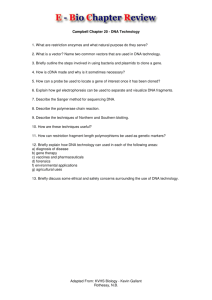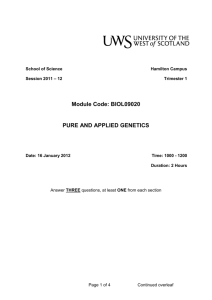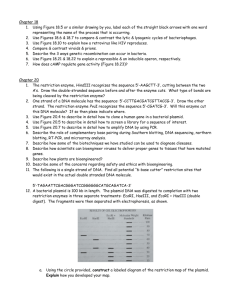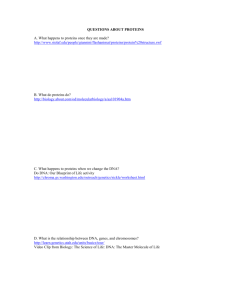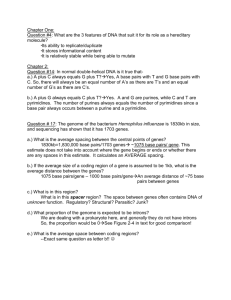Review AP Labs
advertisement
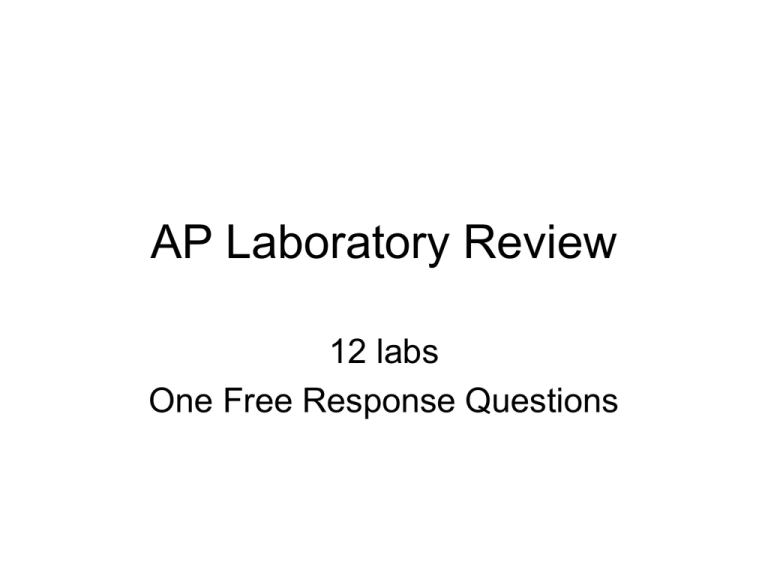
AP Laboratory Review 12 labs One Free Response Questions Diffusion and Osmosis • • • • Water Potential Osmosis Diffusion Hyper, Hypo, Isotonic Potato Before Molarity of 1 0.8 0.6 0.4 0.2 0 0.7 0.65 0.7 0.9 0.7 0.66 Potato After 0.6 0.5 0.7 1 0.8 0.69 Change -0.1 -0.15 0 0.1 0.1 0.03 % change in mass -14% -23% 0% 11% 14% 5% % change in mass Change in Mass by % 20% 10% 0% -10% 0 0.2 0.4 0.6 -20% -30% Molarity 0.8 1 1.2 Series1 Linear (S Enzyme Catalase • • • • • • • • Substrate Enzyme Titration? Gas produced pressure Hydrogen Peroxide Effect Temp. Effect pH Effect Substrate Effect Enzyme Ml. substrate consumed Chart Title 1 21 58 0.5 0 30 92 0 0 20 40 60 80 100 100 temp. deg. C ml Sub. Consumed Poly. (ml Sub. Consumed) 120 Mitosis and Meiosis • Stages of Mitosis • Meisosis • Crossing Over Photosynthesis lab • Chromatography • Measure Rate of Photosynthesis Transpiration lab • Temp. • Wind Speed • Relative Humidity Vascular Tissue Xylem (wood) trachieds and vessel elements make up xylem. They are nonliving conduits with openings at the ends for water movement. Transport in Vascular Plants • Water and minerals begin movement by osmosis. through root and root hair Transport in Plants cont. capillary action in xylem vessel element Adhesion-water vessel wall Cohesion- water to water transpiration out through stoma. H2O closed Group Time 10 20 30 Room 0.06 0.04 0.03 Heat 0.07 0.07 0.07 Fan 0.03 0.05 0.01 Closed Bag 0.07 0.07 0.05 0 0 0 0.03 0.09 0.03 Closed Bottom Closed Top Light Bottle B O D db Scree n1 2 3 4 8 Nutrients Day 1 DO 7 5.5 6 5.5 90 90 Day 3 7 5.5 DO 5 4 5 2 CO2 10 18 8 14 DO 7 2 2 5.5 CO2 9 17 19 12 CO2 % light Db- dark bottle 90 6 5 BOD biological oxygen demand Primary Productivity Gross Productivity NET Productivity= GP- Respiration eutrophication • Raises productivity but results in much decomposition lowering DO and raising CO2 •PPLL X ppll •F1 all PpLl •F2 PpLl X PpLl •From 500 offspring •281 purple long •93 purple round •93 red long •31 red round •F2 hybrid crosses •Should yield a •9:3:3:1 ratio Linkage Maps • Map units or centimorgans = cross over or recombination frequencies Based on crossover frequencies or the frequencies that genes are recombined in ways that suggest they are linked together. Measured in linkage units or Morgan Units 18% •6 % C D B A 5% 13% C----7----A----6----B---5--D *If the ratios deviate from the expected ratio they could indicate that genes are linked. *If genes are linked they are inherited together unless they are separated as a result of crossing over. Resulting in 1:1:1:1 ratios *The frequency that these genes are then separated represents the relative distance they are from each other. Hardy-Weinberg- Microevolution • Describes those conditions that can lead to changes within a population’s genes GENE POOL- the sum total of all genes in a breeding population GENETIC DRIFT- changes in the frequency of an allele The gene frequencies of alleles • For a gene locus where only two genes occur in a pop. Let p = the frequency of one allele and q = the frequency of the other. • Then p + q = 1 ex. ( A + a = 1 ) When gametes combine: The probability of generating a AA genotype is p2 The probability of generating a aa genotype is q2 The prob. of Aa is 2pq Hardy -Weinberg Principle States that if the following conditions occur that the gene pool will not change: • • • • • if matings are random if there are no mutations if there are no migrations if the population remains large if there is no natural selection These do not all happen in Nature !!!!!! The principle is stated as a null hypothesis Any one of these conditions lead to genetic change? • If matings are not random not all genes are shared equally ( Amish, Jews, and other isolated groups ) • Migrations add to or remove genes • Mutation- changes gene pool quickly • Populations are small - inbreeding Evolution of Populations Hardy-Weinberg theorem describes microevolution or changes within a populations gene pool The equation used to express gene frequencies within a pop. P2 +2pq +q2 = 1 The Bottleneck Effect • Natural disasters reduce the size of a population. The smaller population is more subject to change than the main group. The Founder Effect • When a few individuals colonize a new habitat. • Galapagous Islands DNA Technology • • Biotechnology or genetic engineering – the use of natural biological systems to produce a product desired by human beings Examples include: • • • • • Gene Cloning DNA Amplification Transgenic Organisms Gene Therapy Chromosome Mapping and Sequencing Gene Cloning Gene Cloning • Recombinant DNA – DNA from two different sources (human and E. coli) • Plasmid – circular DNA used to transport the gene into the organism • Enzymes needed – Restriction and Ligase • Host cell – usually bacteria, wall must become competent in order for the bacteria to uptake the •Restriction enzyme cleaves DNA and allows for DNA fragment to insert at the sticky ends •Vector – method of transporting a gene cDNA • Use a reverse transcriptase ( viral enzyme ) Causes an isolated mRNA strand to be transcribed into DNA Sanger Method of DNA Sequencing 1. Heat DNA Strands until they separate 2. Add nucleotides and DNA Polymerase 3. Add Dedeoxynucleotides (A, T, G, and C) at different time periods to stop replication 4. Place fragments in to Gel Electrophoresis 5. Allow to migrate and read the Base Sequence DNA Amplification- clone or PCR Polymerase Chain Reaction – PCR • Used to make multiple copies of the same gene (amplify) Probes –Use radioactive isotopes Phosphorous –Will hybridize with complimentary strands Electrophoresis • Restriction enzymes – sequence- determine the order of the bases • RFLPs – Restriction Fragment Length Polymorphisms – used to probe a region of DNA or to identify individuals DNA Fingerprinting • Treat suspects’ blood with the same restriction enzyme • Place sample in Gel Electrophoresis • Allow samples to migrate • Compare the suspects with the blood found at the crime scene • Used in Criminal Trials: OJ Simpson – OJ – DNA was an exact match yet he was found not guilty? Human Genome Project • Map the entire human genome • Start with a linkage map • Use probes and sequencers Human Genome Project • A single human chromosome may contain more than 250 million DNA base pairs, and it is estimated that the entire human genome consists of about 3 billion base pairs. • The ultimate goal of HGP is to associate human traits and inherited diseases with particular genes. • It promises to revolutionize both therapeutic and preventive medicine Chromosome Mapping • 30,000 human genes • RFLPs – Restriction Fragment Length Polymorphisms – used to tag a region of DNA – visible under a microscope • Restriction enzymes – sequence AA • Specific base digestion Gene Therapy • Delivering the defective gene to the cells that need it to produce a protein • Cystic Fibrosis • Vector – method of transporting a gene (virus, plasmid) – Mechanical - usually a laboratory tool used (inoculating loop) – Biological - part or whole of an organism (bacteria)

![Instructions for BLAST [alublast]](http://s3.studylib.net/store/data/007906582_2-a3f8cf4aeaa62a4a55316a3a3e74e798-300x300.png)
